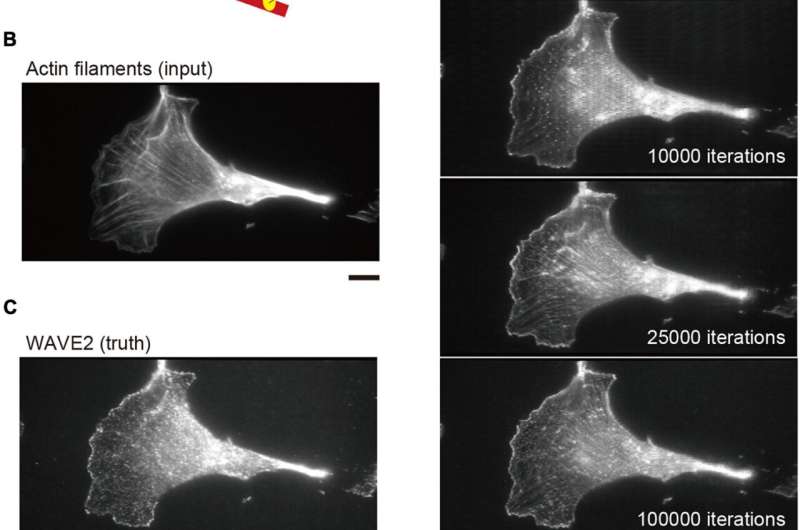Figure 1. Lamellipodia and WAVE2 localization in Swiss 3T3 cells. (A) Schematic illustration of the configuration of actin filaments and WAVE2 localization at lamellipodia. Upon Rac1 activation, the WAVE2 in the protein complex is activated, leading to the activation of the Arp2/3 complex for branched actin filament formation. IRSp53 cooperates with WAVE2 for its activation by Rac1 at the plasma membrane. (B) Input image of actin filaments in Swiss 3T3 cells expressing the active form of Rac1. Actin filaments were stained by Rhodamine–phalloidin. Lamellipodia are fan-shaped structures formed at cell edges. (C) Actual WAVE2 image co-immunostained with panel (B), showing accumulation at the edges of lamellipodia. (D) Progress of the WAVE2 image generation. Images are shown at every 2,500 iterations (1 epoch). The iteration number is shown in the images. Image generation starts with a gray image without any features. Scale bars, 10 μm. Credit: DOI: 10.3389/fcell.2021.635231
Facial recognition software can be used to spot a face in a crowd; but what if it could also predict where someone else was in the same crowd? While this may sound like science fiction, researchers from Japan have now shown that artificial intelligence can accomplish something very similar on a cellular level.
In a study published in Frontiers in Cell and Developmental Biology, researchers from Nara Institute of Science and Technology (NAIST) have revealed that a machine learning program can accurately predict the location of proteins related to actin, an important part of the cellular skeleton, based on the location of actin itself.
Actin plays a key role in providing shape and structure to cells, and during cell movement helps form lamellipodia, which are fan-shaped structures that cells use to "walk" forwards. Lamellipodia also contain a host of other proteins that bind to actin to help maintain the fan-like structure and keep the cells moving.
"While artificial intelligence has been used previously to predict the direction of cell migration based on a sequence of images, so far it has not been used to predict protein localization," says lead author of the study, Shiro Suetsugu. This idea came in during the discussion with Yoshinobu Sato at the Data Science Center in NAIST. "We therefore sought to design a machine learning algorithm that can determine where proteins will appear in the cell based on their relationship with other proteins."
To do this, the researchers trained an artificial intelligence system to predict where actin-associated proteins would be in the cell by showing it pictures of cells in which the proteins were labeled with fluorescent markers to show where they were located. Then, they gave the program pictures in which only actin was labeled and asked it to tell them where the associated proteins were.
"When we compared the predicted images to the actual images, there was a considerable degree of similarity," states Suetsugu. "Our program accurately predicted the localization of three actin-associated proteins within lamellipodia; and, in the case of one of these proteins, in other structures within the cell."
On the other hand, when the researchers asked the program to predict where tubulin, which is not directly related to actin, would be in the cell, the program did not perform nearly as well.
"Our findings suggest that machine learning can be used to accurately predict the location of functionally related proteins and describe the physical relationships between them," says Suetsugu.
Given that lamellipodia are not always easy for non-experts to spot, the program developed in this study could be used to quickly and accurately identify these structures from cell images in the future. In addition, this approach could potentially be used as a sort of artificial cell staining method to avoid the limitations of current cell-staining methods.
More information: Kei Shigene et al, Translation of Cellular Protein Localization Using Convolutional Networks, Frontiers in Cell and Developmental Biology (2021). DOI: 10.3389/fcell.2021.635231
Provided by Nara Institute of Science and Technology
























